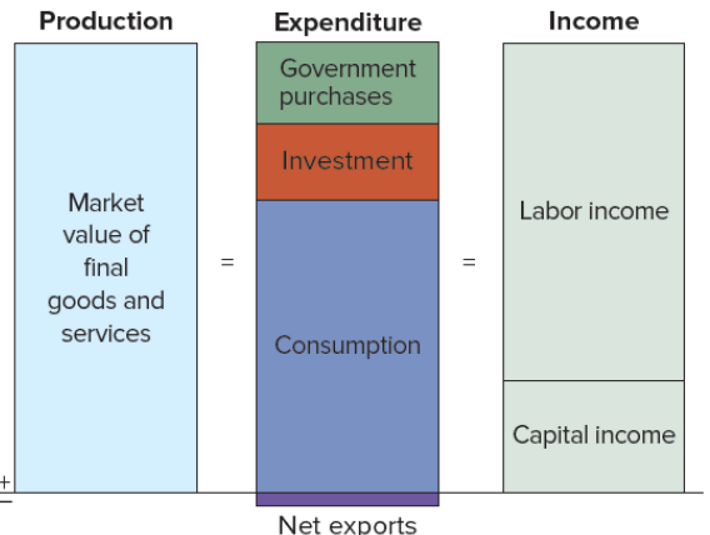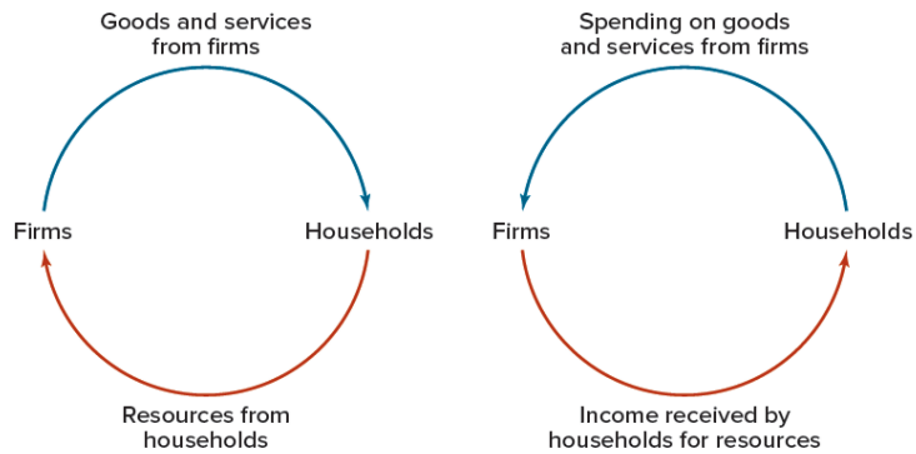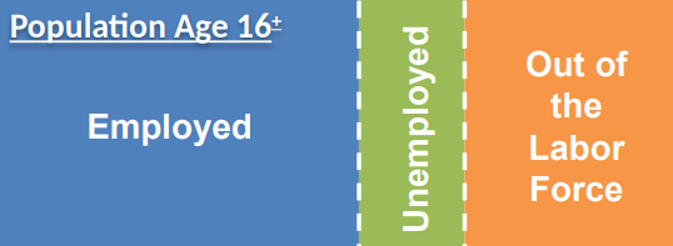GDP and Unemployment
1/82
There's no tags or description
Looks like no tags are added yet.
Name | Mastery | Learn | Test | Matching | Spaced |
|---|
No study sessions yet.
83 Terms
How do Economists Measure the State of the Economy?
gross domestic product - GPD
Gross Domestic Product (GDP)
The market value of final goods and services produced in a country during a given period
Economists aggregate the quantities of many different goods and services into a single number by adding up the market values of the different goods and services that the economy produces
Why is Measuring GDP Criticised?
its doesn’t accurately reflect factors such as distribution of income and the effect or economic growth on the environment
Measuring Output

Market Value
provide a convenient way to aggregate the many different good and services produced in a modern economy
however, not all economically valuable goods and services are bought and sold in markets
Government Goods and Services in GDP Measurement
Not Sold in Markets → No market-determined prices
Provide Societal Benefits (e.g., infrastructure, parks, street lighting, basic research, communications)
Challenges in Valuation
Quantities Are Known, But Prices Are Not
Resource allocation is determined by budgets and policy, not market forces
No direct exchange of money between buyers and sellers
GDP Measurement Issues
Valued at Cost
Government production is measured by its cost, not by its market value
Government Goods and Services Potential Overstatement of GDP
Waste and inefficiency (e.g., lack of competition, corruption, political factors)
Public spending may not accurately reflect its economic value
Government Goods and Services in GDP Resource Misallocation Risks
If public projects are inefficient or politically motivated, resources may be wasted
Deadweight Loss: Costs of production may exceed societal benefits
Government Goods and Services in GDP Social Welfare Considerations
Market prices may not reflect the true social value of these goods
Public goods often lead to market failure if left to private markets
Government Goods and Services in GDP Impact on Economic Output
Stimulates demand and economic activity
Injects money into the economy
Increases production capacities
Final Goods and Services
Consumed by the ultimate user
End products of production
Included in GDP
Capital/Intermediate Goods and Services
a long lived good, which is itself produced and used to produce other goods and services
not directly consumed by households
not included in GDP to avoid double counting
Capital/Intermediate Goods Examples
Buildings & Infrastructure – Houses, apartments, motels
Equipment & Machinery – Restaurant stoves, tools in cooking schools
Vehicles for Business Use – Delivery trucks, taxis
Is Money a Capital Good?
no - it facilitates transactions but doesn’t produce goods or services itself
Value Added
the market value of the product minus the cost of inputs purchased from other firms
you count value added in the year it is produced
What does Domestic mean in GDP?
the activity is measured within a country's borders
(nationality of owners or company is not relevant)
4 Categories of Users of Final Goods and Services
Households
Firms
Governments
Foreign sector
Economists assume that all final goods and services that are produced in a country in a given year will be purchased and used by members of one or more of the four groups
Expenditure Method for Measuring GDP
GDP can be measured with equal accuracy by either of two methods:
Adding up the market value of all the final goods and services that are produced domestically
Adding up the total amount spent by each of the four groups on final goods and services and subtracting spending on imported goods and services
Consumption Expenditure
spending by households for goods and services
Consumer Durables
long-lived consumer goods
e.g. cars, furniture, appliances
Consumer Non-Durable Goods
shorter-lived goods
e.g. clothing, food ,bedding
Services
largest component of consumer spending
e.g. education, taxis, haircuts
Investment
Spending by firms on final goods and services
Aimed at increasing the production capacity of the economy
Business Fixed Investment
purchases of new capital goods
e.g. plant, property, equipment
Residential Investment
construction of new homes and apartment buildings
Inventory Investment
the change in unsold goods to the company’s inventory
these goods are produced but not yet sold
can be positive or negative
Financial Investment
purchases of stocks, bonds, and other financial assets
generally transfers ownership of a portion of the firm's existing capital stock
doesn’t correspond to any increase in physical capital or production capacity, in most cases
new stock issues can be an exception
Economic Investment
the increase in the capital goods used to produce other goods
value is based on the purchase price of the capital goods, not on stock value
Government Purchases
Final goods and services bought by federal, state, and local governments
e.g. Fighter jets, Teaching, Office Supplies
Excludes transfer payments (redistribution) and interest paid on government debt
Transfer Payments
made by government, but the government receives no current goods or services
e.g. social security, food stamps
no purchases of final goods and services involved - no added production - spending by recipients is included in GDP
Net Exports Calculation
exports - imports
Exports
goods and services produced domestically and sold abroad
reduce the amount available to the domestic economy
Imports
purchases in the US of goods and services produced abroad
can be consumption, investment or government spending
increase the amount available to the domestic economy
GDP Expenditures Equation
Y = C + I + G + NX
Y - GDP or output
C - Consumption Expenditure
I - Investment
G - Government Purchases
NX - Net Exports
Income Approach to GDP
when a good is sold, its proceeds are distributed to workers or business owners
GDP Equation
labour income + capital income
Labour Income
wages, salaries, benefits, and incomes of the self-employed
About ⅔ of GDP
Capital Income
pays for physical capital and intangibles
Profits for business owners
Rent for land
Interest for bond holders – Measured before taxes
Royalties
3 Faces of GDP

Circular Flow Diagram

Adjusting for Price Changes
Compare GDP for different years to see how much output has changed
To see how much output has grown, use only the changes in quantities
Hold prices constant
Why does GDP Change over Time?
Prices change AND
Quantity of output changes
Nominal GDP
a measure of GDP in which the quantities produced are valued at current-year prices
measures the current money value of production
Real GDP
a measure of GDP in which the quantities produced are valued at the prices in a base year, rather than at current prices
measures the actual physical volume of production
What Normally happens to Real and Nominal GDP?
usually they increase each year
Why is Real GDP rising and Nominal GDP falling rare?
historically prices fall faster than the increase in output
What happens if Nominal GDP goes up while Real GDP does down?
fewer goods and services produced
prices increase faster than output decreased
Why would Nominal GDP be Smaller than Real GDP?
the prices in the current year are less than the base year
usually true for years before the base year
GDP and Economic Well-Being
GDP does not directly measure those things that make life worthwhile, but it does measure our ability to obtain many of the inputs into a worthwhile life
What does Real GDP Omit?
illegal transactions
volunteer work
household production
leisure
Will Maximising GDP Maximise Wellbeing?
not necessarily, its a case-by-case issue
What would the Loss from Reduced Leisure Offset?
the gain from producing and consuming a greater quantity of goods and services
Underground Economy
all unreported transactions, legal and illegal
some underground activity is illegal
a service of value is provided
drug dealers, bookies, fences, prostitution, etc
estimates suggest the underground economy is large regardless of national income level
Casual Labour is Paid in?
cash - failure to report this reduces taxes
Environmental Quality
Clean-up activities are included in GDP
Gets environment back to its starting point, not better
The deterioration in the quality of air and water would more than offset the gains from greater production
Resource Depletion
No adjustment is made for the decline in resource availability when mining or other harvesting is done
What Other Intangibles does GDP not Value?
Crime rates
Traffic congestion
Civic organizations
Open space
Sense of community
Poverty and Economic Inequality
GDP does not capture the effects of income inequality
US uses an absolute standard of poverty
Inequality matters and it is increasing in the US
GDP cannot differentiate between an unequal and an egalitarian society if they have similar economic sizes
As rising inequality is resulting in a rise in societal discontentment and increased polarization, policymakers will need to account for these issues when assessing development
GDP Limitations
tells us about aggregate consumption, but it does not tell us about personal well-being
tells us about production, but not about the pollution that comes with it, or the depletion of natural resources it requires
tells us about government expenditure and private investments, but not about the quality of life they generate
as global annual GDP peaked, our ecological footprint did so too, leading to an ecological deficit
forests were cut to make way for agriculture and industry, oceans were depleted of their fish stocks, and fossil fuels were burned and polluted the air, leading to climate change
in the short-term that lead to growth, in the long-term it damaged our health, wealth and well-being
GDP as a Welfare Measure
GDP omits and undervalues some goods and services
GDP per capita is positively associated with several measures of well-being
Material standard of living: more goods and services
Health and life expectancy
Education
What do Countries with High Real GDP per Head of Population tend to have?
higher life expectancy
lower infant mortality
better nutrition and healthcare
Unemployment
The working age population fall into:

What Happens when the Unemployment Rate is Low?
jobs are secure and relatively easy to find
Employed
a person who works full/part time, or is on vacation or sick leave from a regular job
Unemployed
a person who isn’t employed but is actively seeking employment
Out of the Labour Force
a person who isn’t employed or actively seeking employment
Labour Force
the total number of people employed and unemployed in the economy
Unemployment Rate
the percentage of the labour force classified as unemployed
Participation Rate
the percentage of the working population in the labour force
calculated by dividing the labour force by the working age population
Types of Unemployment
frictional unemployment
structural unemployment
seasonal / cyclical unemployment
add up to total unemployment rate
Frictional Unemployment
short-term
associated with the process of matching workers with jobs
the process of matching workers with jobs
Structural Unemployment
long-term and chronic
exists even when the economy is producing at the normal rate
several factors contribute:
A lack of skills
Language barriers
Discrimination
economic changes sometimes create a long-term mismatch between the skills that some workers have and the available jobs
What Substantial Economic Losses does Long-Term Unemployment Cause to Society?
loss of income for workers and loss of output for firms
Seasonal/Cyclical Unemployment
extra unemployment
occurs during the periods of recession
occurs when the economy experiences a decline in the demand for the goods and services it produces
Economic Costs of Unemployment
Lost wages and production
Decreased taxes and increased transfers
Psychological Costs of Unemployment
Individual self-esteem
Family stress of decreased income and increased uncertainty
Social Costs of Unemployment
Potential increases in crimes and social problems
Social resources spent to address these
Long-Term Unemployed
have been out of work for 6 months or longer
Short-Term Unemployed Outcomes
find a permanent job after searching a few weeks
economic costs are low
leave the labour force
short-term/temporary job that leads to unemployment again
these chronically unemployed have costs similar to the long-term unemployed
Unemployment Spell
the period during which an individual is continuously unemployed
Duration of Unemployment
the length of the unemployment spell
Discouraged Workers
would like to have a job but they have not looked for work in the past four weeks because they believe they are no jobs available
counted as out of the labour force
could be counted as unemployed but they are not
Involuntary Part-Time Workers
people who like to work full time but can’t find a full time job
counted as employed